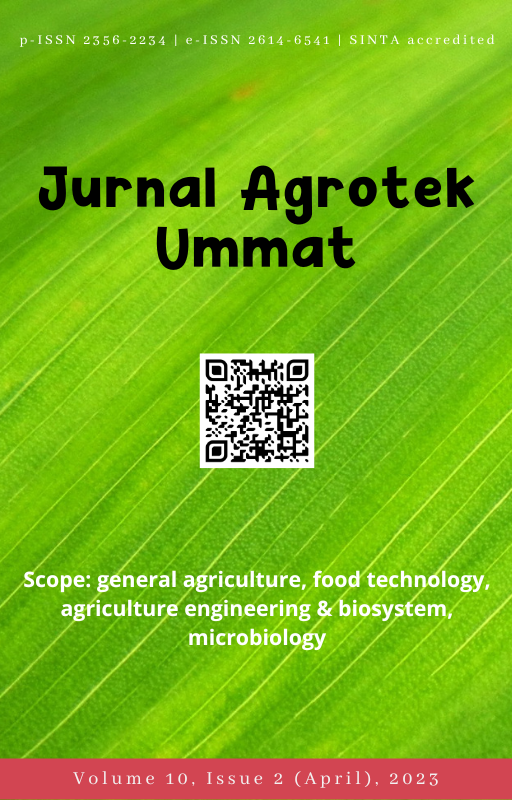Bulk density and water capacity analysis at magot compost and at soil containing pumice on Lombok Island
DOI:
https://doi.org/10.31764/jau.v10i2.14518Keywords:
berat jenis, kapasitas air, kompos magot dan tanah pumiceAbstract
Mineral soil has a high bulk density and is a limiting factor as a nursery medium. For the application of nursery media, planting media that is light, large water holding capacity are also needed. The magot compost comes from the Magot Lingsar unit the Regional TPA of NTB Province and the soil contains pumice an average of 68.2% comes from Tanak Beak Village, Central Lombok Regency, which has potential as a medium for nurseries. The purpose of this study was to identify the Bulk Density and water holding capacity of magot compost and soil containing pumice with the control variable of mineral soil from Labuapi, West Lombok Regency. Bulk density analysis method by analyzing dry weight per unit volume on soil rings and water capacity by analyzing wet weight minus dry weight. The subjects studied were magot compost with size < 2 mm, soil containing pumice size < 2 mm and control soil mineral rice fields. The results showed that the lowest Bulk Density was magot compost 0.42 gr/cm3, soil containing soil 0,64 gr/cm3, and rice field soil 1.42 gr/cm3, this was because magot compost was residue from waste. While the largest water holding capacity was soil containing pumice of 42.67%, magot compost 22.00%, and paddy soil 6.33%, caused by the number of macro and micro pores in pumice, whereas in magot compost water is bound to the humus surface. Suggestions for further research are the permanent wilting point time test on plant seeds.
References
Agviolita, P., Yushardi, Y., & Anggraeni, F. K. A. (2021). Pengaruh Perbedaan Biochar terhadap Kemampuan Menjaga Retensi pada Tanah. Jurnal Fisika Unand, 10(2). https://doi.org/10.25077/jfu.10.2.267-273.2021
Arabia, T., Syakur, S., & Irawan, B. (2018). Karakteristik Tanah Inceptisol yang Disawahkan. In J.Floratek (Vol. 13, Issue 1).
Bagus, A. Z., & Widodo, S. (1999). Efek Perbedaan Faktor Air Semen Terhadap Kuat Tekan Beton Ringan Agregat Breksi Batu Apung. Jurnal UNY.
Bram Martin, A., Same, M., Indrawati, W., Budidaya Tanaman Perkebunan dan, J., & Pengajar Jurusan Budidaya, S. (2015). Pengaruh Media Pembibitan pada Pertumbuhan Setek Lada (Piper nigrum L.). Jurnal Agro Industri Perkebunan, 3.
Gaus, A., Imran, & Anwar, C. (2020). Analysis of the Mechanical Properties of Concrete Beams That Use Batu apung as a Partial Substitution of Concrete Mixtures. Journal of Physics: Conference Series, 1569(4). https://doi.org/10.1088/1742-6596/1569/4/042037
Gaus, A., Imran, I., Anwar, C., & Novianti, L. (2019). Experimental Study of the Use of Batu apung Sand in the Rigid Pavement. EPI International Journal of Engineering, 2(1). https://doi.org/10.25042/epi-ije.022019.11
Kurniawan, A., Susanti, F., & Yunianti, S. R. (2020). Strategy to develop tourism objects at Ijobalit, a former batu apung mine in East Lombok. IOP Conference Series: Earth and Environmental Science, 413(1). https://doi.org/10.1088/1755-1315/413/1/012028
Kusuma Purnamasari, D., Julia Ariyanti, B. M., & Erwan, dan. (2021). Potensi Sampah Organik Sebagai Media Tumbuh Maggot Lalat Black Soldier (Hermetia illucens) (The Potency of Organic Waste as Growth Media of Black Soldier Fly (Hermetia illucens) Maggot). Jurnal Ilmu Dan Teknologi Peternakan Indonesia, 7(2), 95–106.
Masthura, M., & Putra, Z. (2018). Karakterisasi Mikrostruktur Karbon Aktif Tempurung Kelapa dan Kayu Bakau. Elkawnie, 4(1). https://doi.org/10.22373/ekw.v4i1.3076
Muanah, M., Karyanik, K., & Romansyah, E. (2020). Rancang Bangun dan Uji Kinerja Penerapan Teknik Irigasi Tetes pada Lahan Kering. Jurnal Agrotek Ummat, 7(2). https://doi.org/10.31764/jau.v7i2.3128
Mulyadi, T., Nurcholis, M., & Partoyo, P. (2021). Beberapa Sifat Kimia Tanah Sawah Atas Penggunaan Pupuk Organik dengan Kurun Waktu Berbeda Di Sayegan, Sleman. Jurnal Tanah Dan Air (Soil and Water Journal), 17(2). https://doi.org/10.31315/jta.v17i2.4237
Raharjo, K. T. P., & Delang, V. R. (2020). Pengaruh Jenis Residu Kompos Biochar dan Umur Defoliasi Daun Jagung (Zea mays L.) terhadap Pertumbuhan dan Hasil Kacang Merah (Phaseulus vulgaris L.) dalam Tumpangsari Salome. Savana Cendana, 5(03). https://doi.org/10.32938/sc.v5i03.1054
Ridha, M., & Darminto, D. (2016). Analisis Densitas, Porositas, dan Struktur Mikro Batu Apung Lombok dengan Variasi Lokasi dan Kedalaman. Jurnal Fisika Dan Aplikasinya, 12(3). https://doi.org/10.12962/j24604682.v12i3.1403
Ritika, P., Satyawatiand, S., & Rajendra, P. (2015). Study on occurrence of black soldier fly larvae in composting of kitchen waste. International Journal of Research in Biosciences, 4(4).
Rosita, S., & Baharuddin, M. (2023). Sifat Fisik Dan Sifat Kimia Tanah Asosiasi Hapludands-Eutrudepts Pada Lahan Berbatu Apung Di Kecamatan Montong Gading Lombok Timur Physical and Chemical Properties ff Soil Association Hapludands-Eutrudepts on Stome Rock in Montong Gading Sub-District, Lombok Timur Regency.
Song, S., Ee, A. W. L., Tan, J. K. N., Cheong, J. C., Chiam, Z., Arora, S., Lam, W. N., & Tan, H. T. W. (2021). Upcycling Food Waste Using Black Soldier Fly Larvae: Effects of further composting on frass quality, fertilising effect and its global warming potential. Journal of Cleaner Production, 288. https://doi.org/10.1016/j.jclepro.2020.125664
Suhairin, S. (2020). Evaluasi Kemampuan Lahan Untuk Arahan Penggunaan Lahan Di Daerah Aliran Sungai Maros Sulawesi Selatan. Jurnal Agrotek Ummat, 7(1). https://doi.org/10.31764/agrotek.v7i1.2352
Sukamto, S., & Rahmat, A. (2023). Evaluation of Ftir, Macro and Micronutrients of Compost from Black Soldier Fly Residual: In Contexs of It Use As Fertilizers. Asean Journal of Science and Engineering, 3(1).
Downloads
Published
Issue
Section
License
Authors who publish articles in Jurnal Agrotek Ummatagree to the following terms:- Authors retain copyright of the article and grant the journal right of first publication with the work simultaneously licensed under a CC-BY-SA or The Creative Commons Attribution–ShareAlike License.
- Authors are able to enter into separate, additional contractual arrangements for the non-exclusive distribution of the journal's published version of the work (e.g., post it to an institutional repository or publish it in a book), with an acknowledgment of its initial publication in this journal.
- Authors are permitted and encouraged to post their work online (e.g., in institutional repositories or on their website) prior to and during the submission process, as it can lead to productive exchanges, as well as earlier and greater citation of published work (See The Effect of Open Access).

